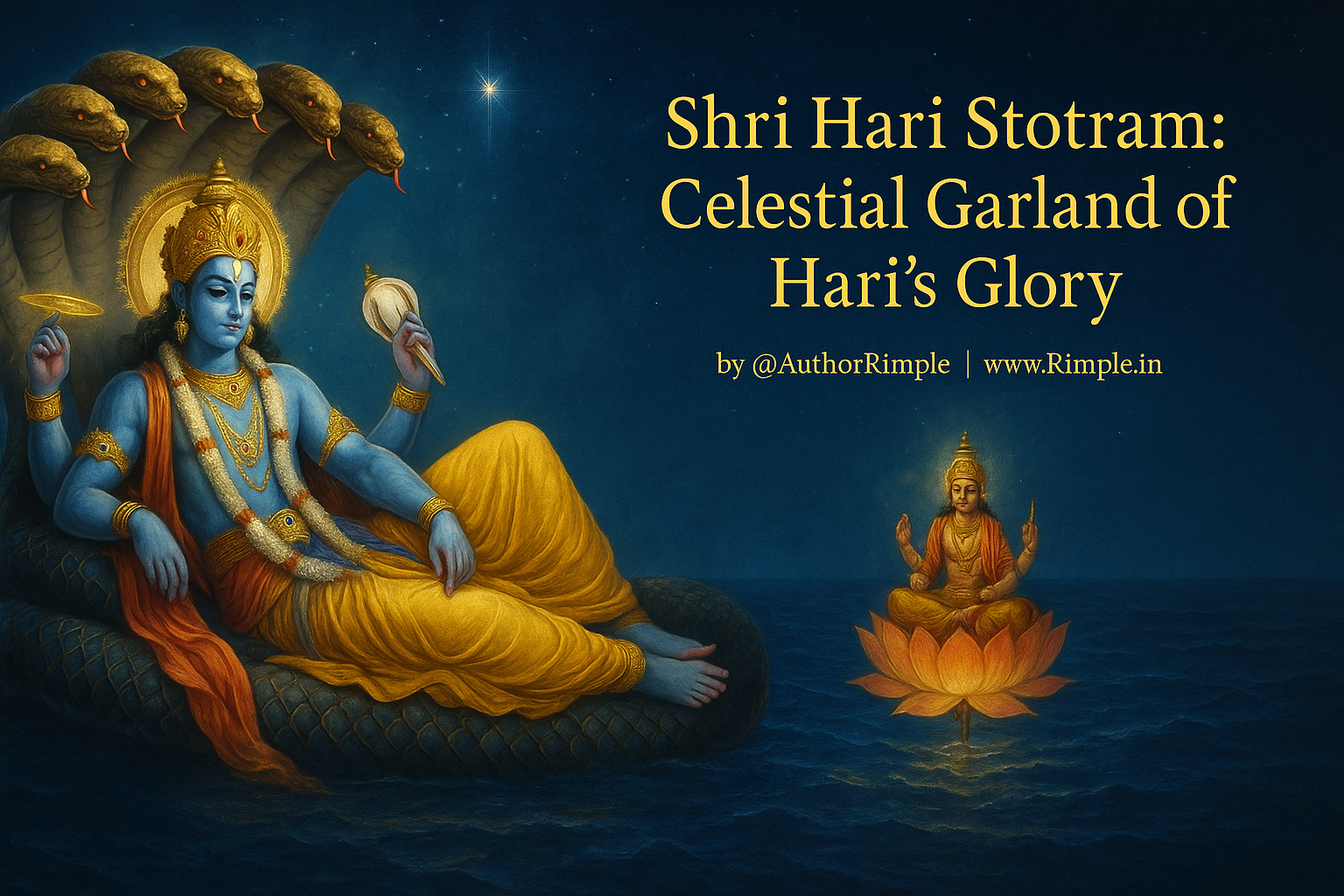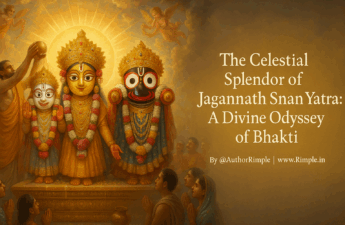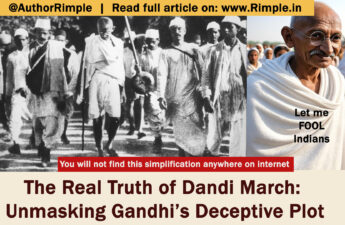Let us embark on a celestial journey through the Shri Hari Stotram, a divine hymn that weaves the infinite glories of Lord Vishnu, the preserver of the cosmos, into eight resplendent verses, crowned with a phalashruti promising eternal liberation. Penned by the revered sage Sri Adi Shankaracharya, this stotram is a luminous tapestry of devotion, each verse a petal in the lotus of divine love, radiating the ethereal beauty of the Supreme. Its words, drenched in the nectar of bhakti, invite the soul to dance in the divine embrace of Vishnu’s boundless grace. Let us unfold each verse, translating its poetic essence and unraveling its meaning with simplicity, yet cloaking every phrase in the radiance of divinity, so that the heart of every reader may tremble with awe and surrender.
Verse 1
Sanskrit:
जगज्जालपालं चलत्कण्ठमालंशरच्चन्द्रभालं महादैत्यकालं
नभोनीलकायं दुरावारमायंसुपद्मासहायम् भजेऽहं भजेऽहं॥1॥
Poetic Translation:
O Guardian of the cosmic web, with a garland swaying on Thy throat divine,
Thy brow adorned with autumn’s moon, radiant, pure, an eternal sign.
Slayer of mighty demons, Thy form a sapphire sky, vast and grand,
With Padma, Thy beloved, by Thy side, I worship Thee, with folded hands.
Simple Explanation:
This verse paints Lord Vishnu as the protector of the entire universe, holding the intricate web of creation in His care, like a shepherd tending to his flock. The garland on His neck sways gently, symbolizing His dynamic presence in the cosmos. His forehead glows like the serene autumn moon, exuding peace. He is the destroyer of great demons (like Madhu and Kaitabha), signifying His power over evil. His body, blue as the infinite sky, is enchanting yet unattainable by illusion (maya). Accompanied by Goddess Lakshmi (Padma), His divine consort, He is the epitome of grace. The devotee declares, “I worship Him, I surrender to Him,” with fervent devotion.
Divine Beauty:
The imagery here is breathtaking—a cosmic protector whose very form is the sky, whose brow is the moon, and whose love is Lakshmi herself. It evokes a sense of awe, as if the universe itself bows to His majesty.
Verse 2
Sanskrit:
सदाम्भोधिवासं गलत्पुष्पहासंजगत्सन्निवासं शतादित्यभासं
गदाचक्रशस्त्रं लसत्पीतवस्त्रंहसच्चारुवक्त्रं भजेऽहं भजेऽहं॥2॥
Poetic Translation:
O Dweller in the ocean’s heart, with smiles like blossoms gently falling,
Abode of all creation, shining with the brilliance of a hundred suns calling.
With mace and discus armed, in radiant yellow robes adorned,
Thy charming face aglow with joy, I worship Thee, my heart transformed.
Simple Explanation:
Lord Vishnu resides in the cosmic ocean (Ksheerasagara), a symbol of His infinite depth and tranquility. His smile is like flowers cascading, spreading joy. He is the home of the universe, containing all beings within Him, like a tree sheltering countless birds. His brilliance outshines a hundred suns, and He wields the mace (gada) and discus (chakra), symbols of power and protection. Clad in vibrant yellow garments, His face beams with divine charm. The devotee again surrenders, chanting, “I worship Him.”
Divine Beauty:
This verse is a cascade of light and love, portraying Vishnu as both the infinite ocean and the radiant sun, His smile a gift of eternal joy. The imagery of His weapons and robes weaves strength with grace, making the heart yearn for His divine presence.
Verse 3
Sanskrit:
रमाकण्ठहारं श्रुतिव्रातसारंजलान्तर्विहारं धराभारहारं
चिदानन्दरूपं मनोज्ञस्वरूपंध्रुतानेकरूपं भजेऽहं भजेऽहं॥3॥
Poetic Translation:
O Beloved of Lakshmi, with wisdom’s garland from the Vedas’ sacred stream,
Thou sporteth in the cosmic waters, lifting earth’s burdens in a dream.
Thy form is pure consciousness-bliss, enchanting in its divine embrace,
Assuming countless forms, O Lord, I worship Thee, enraptured by Thy grace.
Simple Explanation:
Vishnu, the beloved of Lakshmi, wears the essence of the Vedas like a garland, embodying ultimate wisdom. He playfully resides in the cosmic waters, like a lotus floating effortlessly. He removes the burdens of the earth, as seen in His Varaha avatar, lifting the world from chaos. His form is pure consciousness and bliss, captivating the mind like a beautiful melody. He takes many forms (like Rama, Krishna) to uplift devotees. The devotee surrenders, saying, “I worship Him.”
Divine Beauty:
This verse is a celestial song, blending wisdom, playfulness, and salvation. The idea of Vishnu as both the blissful essence and the multifaceted savior stirs the soul, making it long to merge with His divine forms.
Verse 4
Sanskrit:
जराजन्महीनं परानन्दपीनंसमाधानलीनं सदैवानवीनं
जगज्जन्महेतुं सुरानीककेतुंत्रिलोकैकसेतुं भजेऽहं भजेऽहं॥4॥
Poetic Translation:
Beyond birth and decay, O Fount of supreme bliss, ever pure,
In meditative depths absorbed, Thy essence ever fresh, ever sure.
The cause of creation’s birth, the banner of the gods’ divine throng,
The bridge across the three worlds, I worship Thee with an endless song.
Simple Explanation:
Vishnu is free from aging and birth, eternal and untouched by time, like a river that never dries. He is filled with supreme bliss and immersed in divine meditation, always new and vibrant. He is the source of the universe’s creation and the leader of the gods, like a flag guiding an army. As the bridge connecting the three worlds (heaven, earth, and the netherworld), He leads souls to liberation. The devotee chants, “I worship Him.”
Divine Beauty:
The verse radiates eternity and transcendence, portraying Vishnu as the timeless source of all, a bridge to salvation. Its lyrical flow feels like a river of grace carrying the devotee to the divine.
Verse 5
Sanskrit:
कृताम्नायगानं खगाधीशयानंविमुक्तेर्निदानं हरारातिमानं
स्वभक्तानुकूलं जगद्व्रुक्षमूलंनिरस्तार्तशूलं भजेऽहं भजेऽहं॥5॥
Poetic Translation:
Sung in sacred scriptures, reclining on the king of birds divine,
The root of liberation’s path, revered by foes of Shiva’s line.
Ever kind to devotees, the root of the cosmic tree’s embrace,
Dispeller of all pain and sorrow, I worship Thee, O Lord of grace.
Simple Explanation:
Vishnu is celebrated in the Vedas and rests on Garuda, the king of birds, symbolizing His sovereignty. He is the source of liberation (moksha), like a spring that quenches spiritual thirst. Even demons (foes of Shiva, like Ravana) revere Him. He is compassionate to His devotees, the root of the universe’s tree, and removes all suffering, like a healer soothing pain. The devotee proclaims, “I worship Him.”
Divine Beauty:
This verse weaves reverence and compassion, with Vishnu as the cosmic root and the ultimate refuge. The imagery of Garuda and the cosmic tree evokes a sense of divine protection and eternal support.
Verse 6
Sanskrit:
समस्तामरेशं द्विरेफाभकेशंजगद्विम्बलेशं ह्रुदाकाशदेशं
सदा दिव्यदेहं विमुक्ताखिलेहंसुवैकुण्ठगेहं भजेऽहं भजेऽहं॥6॥
Poetic Translation:
Lord of all the gods, with locks like bees in nectar’s sweet embrace,
A spark of the cosmic form, dwelling in the heart’s ethereal space.
Thy form divine, eternal, free from worldly ties, pure and bright,
Abode in Vaikuntha’s glory, I worship Thee, O radiant light.
Simple Explanation:
Vishnu is the supreme lord of all deities, His dark hair resembling bees drawn to nectar, symbolizing His irresistible charm. He is a fragment of the infinite cosmic form, residing in the heart of every being, like a star in the sky of the soul. His divine form is eternal, untouched by worldly desires, and He resides in Vaikuntha, the celestial abode. The devotee chants, “I worship Him.”
Divine Beauty:
The imagery of bees and the heart’s space is profoundly poetic, making Vishnu both cosmic and intimate. The verse invites the soul to find Him within, in the sacred Vaikuntha of the heart.
Verse 7
Sanskrit:
सुरालिबलिष्ठं त्रिलोकीवरिष्ठंगुरूणां गरिष्ठं स्वरूपैकनिष्ठं
सदा युद्धधीरं महावीरवीरंमहाम्भोधितीरं भजेऽहं भजेऽहं॥7॥
Poetic Translation:
Mightiest among the gods, supreme in the three worlds’ sacred sphere,
Greatest of all gurus, steadfast in Thy singular form, revered.
Ever brave in battle, the hero of heroes, vast as the ocean’s shore,
I worship Thee, O boundless one, with love forevermore.
Simple Explanation:
Vishnu is the most powerful among gods, reigning supreme over heaven, earth, and the netherworld. He is the ultimate teacher (guru), unchanging in His divine essence. Courageous in cosmic battles (like against Hiranyakashipu), He is the greatest hero, vast as the ocean’s edge. The devotee surrenders, saying, “I worship Him.”
Divine Beauty:
This verse exudes strength and reverence, portraying Vishnu as both a warrior and a sage. The ocean imagery amplifies His vastness, stirring awe and devotion in the reader’s heart.
Verse 8
Sanskrit:
रमावामभागं तलानग्रनागंकृताधीनयागं गतारागरागं
मुनीन्द्रैः सुगीतं सुरैः संपरीतंगुणौधैरतीतं भजेऽहं भजेऽहं॥8॥
Poetic Translation:
With Lakshmi on Thy left, O Lord, subduing serpents with Thy might,
Guiding sacred rituals, free from passion’s fleeting, transient flight.
Sung by sages, worshipped by gods, beyond all virtues’ boundless stream,
I worship Thee, O divine essence, in Thy love’s eternal dream.
Simple Explanation:
Vishnu, with Lakshmi by His side, subdues serpents (like Kaliya), symbolizing His mastery over evil. He guides sacred rituals (yagnas), free from worldly desires. Praised by sages and gods, His virtues transcend description. The devotee chants, “I worship Him.”
Divine Beauty:
This verse is a crescendo of devotion, blending Vishnu’s power, purity, and divine love. The imagery of Lakshmi and the serpents creates a vivid tableau of grace triumphing over chaos.
Phalashruti (Verse 9)
Sanskrit:
इदं यस्तु नित्यं समाधाय चित्तंपठेदष्टकं कण्ठहारम् मुरारेः
स विष्णोर्विशोकं ध्रुवं याति लोकंजराजन्मशोकं पुनर्विन्दते नो॥9॥
Poetic Translation:
Whoever, with a heart serene, chants this octet, Murari’s garland bright,
Shall reach Vishnu’s sorrowless realm, where eternal bliss takes flight.
Free from birth and aging’s pain, never to return to grief’s dark shore,
In His divine embrace, they dwell, forever blessed, forevermore.
Simple Explanation:
This verse describes the fruit of chanting the stotram daily with devotion. It is likened to a garland adorning Lord Vishnu (Murari). Such a devotee attains Vishnu’s divine realm, free from sorrow, birth, and aging, never returning to the cycle of suffering.
Divine Beauty:
The phalashruti is a promise of eternal liberation, a beacon of hope that elevates the soul. It assures that devotion to Vishnu is a path to transcendence, wrapped in divine love.
The Beauty and Significance of Shri Hari Stotram
The Shri Hari Stotram is a celestial symphony, each verse a note in the divine melody of Lord Vishnu’s glory. Composed by Adi Shankaracharya, the great Advaita philosopher, this hymn is a testament to his profound devotion to Vishnu, blending the impersonal Brahman with the personal, loving form of Hari. Its eight verses, like eight lotus petals, unfold the infinite attributes of Vishnu—His cosmic guardianship, His radiant beauty, His compassion, and His role as the bridge to liberation. The repetition of “bhaje’ham bhaje’ham” (I worship Him) is a heartbeat of surrender, drawing the devotee closer to the divine with every chant.
The stotram’s beauty lies in its lyrical richness and spiritual depth. Each verse paints Vishnu in vivid, poetic imagery—His blue form like the sky, His smile like falling flowers, His presence in the heart’s space. These metaphors make the divine accessible, like a friend who is both majestic and intimate. The stotram’s significance is its power to purify the mind and awaken bhakti. It is a ladder to Vaikuntha, each verse a step toward liberation. Its rhythmic cadence and divine descriptions create a meditative flow, enveloping the chanter in Vishnu’s grace.
For all who recite or hear it, the Shri Hari Stotram is a sacred offering, a garland of words laid at Vishnu’s feet. It stirs the soul, ignites devotion, and promises eternal union with the Divine. Let its verses be chanted with love, and may the heart of every reader become a temple where Hari resides, radiant and eternal.
Also Read:





